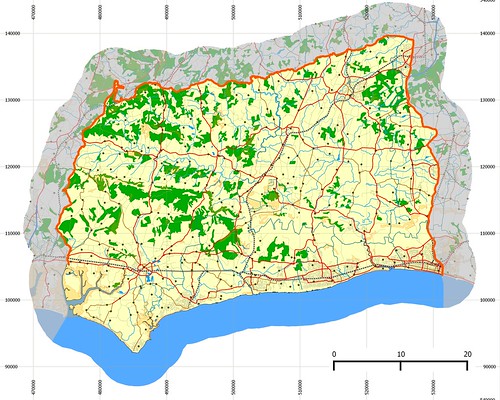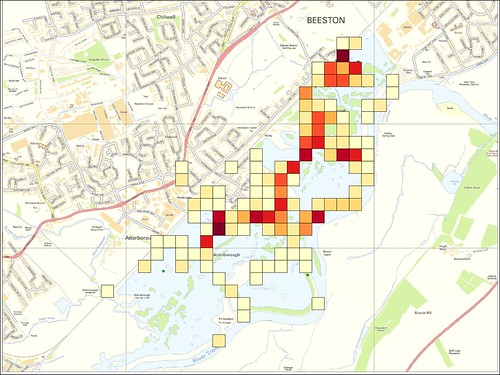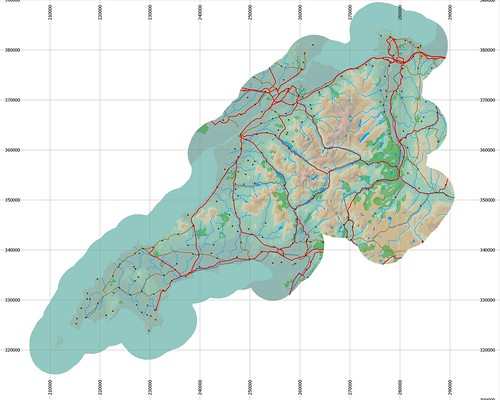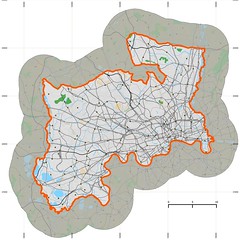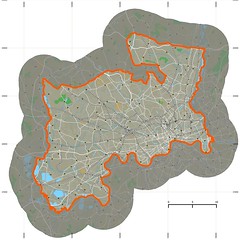Yesterday I came across a blog post on the
OSM-GB site: this is a project hosted at Nottingham University which is about
"Measuring and Improving the Quality of OpenStreetMap for Great Britain".
Although I've been aware of this project for a while it's never appeared to have much visibility within the OSM community. In part this is because it is aimed at certain classes of professional GIS users, and many of its services are WMS or WFS based.
Tom Chance and James Rutter both seem to be pleased with some of the things it can do.
The blog post is concerned with 'conflating' an Ordnance Survey OpenData set (VectorMap District - VMD and OSM). VMD is the vector data underlying the StreetView tiles (roughly 1:10k scale) and the road centrelines are likely to be more accurate than OSM. It is (perhaps deliberately) lacking in some attribution (notably road names), and is designed for rendering (roads and waterways under bridges don't exist).
Only major (motorways, A- and B-roads are named and numbered). It is this latter set which has been compared with OSM in the conflation process. All differences are shown on the OSM-GB slippy map on the front page of the website. However, the conflation process assumes that the
VMD data is always better than OSM. Unfortunately, one of the examples highlighted in the blog is a case where OSM is correct and the Ordnance Survey are wrong. Like a lot of mappers I do care about the accuracy of the data: I hate to get things wrong, and if I'm not sure or don't have enough information I'll try and ensure that this is shown in the tags.
I've borrowed the image of Gregory Street, Lenton from the
OSM-GB blog, which shows the length of road where OSM and OS VMD data disagree.
 |
| Mismatched OS VMD and OSM data from OSM-GB blog. |
When I surveyed this in 2009 I spent quite some time trying to work out what this stretch of road was called. At the traffic lights there is a street sign "Gregory Street leading to Lenton Lane", but the next streetname plate is not to be found until just S of the canal bridge: this one has "Lenton Lane". I took this as
prime facie evidence that Lenton Lane only started beyond or on the bridge (called Clayton's Bridge). I never sorted out in my own mind whether the canal bridge is on Gregory
Street or Lenton Lane: the available evidence on the ground cannot be
used to resolve the issue.
House numbering also confirms this: there is row of former council houses numbered from 33 to 67. If Lenton Lane started at the junction with Old Church Street then one would expect the numbering to start from 1.
Last night I did some more research to make sure I hadn't got this completely wrong. There are a good number of pieces of evidence to support my original mapping, plus one which doesn't.
- Inspection of the Nottingham City Council GIS shows that these have a street address of Gregory Street and a postcode of NG7 2NL. House numbering is continuous from Abbey Bridge junction (the former Red Cross building is 31, to the last house next to Kirk’s auctioneers). This accords with m own mapping of the numbers for these houses. Similarly the Red Cow also has a Gregory Street address, even if the current management seem to think it's on Lenton Lane.
- Historical mapping (for instance at Nottingham Insight) was less useful, other than to confirm that the name "Lenton Lane" is recent (it was known as Trent Lane until at least 1945). The label for "Gregory Street" always stops just before Old Church Street. However, there would have been no reason for a name change at this point, or at the crossroads: the street network was altered in the 1920s when Abbey Bridge was built as part of Jesse Boot's improvements associated with University Park.
- The Lenton Local History Society does have a page on Gregory Street, and this shows that the Red Cow pub was on this street.
- A Historical Street Directory, Wright's Directory of 1911, accessible on the University of Leicester website covers Gregory Street on page 70. This shows that existing locations such as the Red Cow Pub and Trevithick's Boatyard had Gregory Street addresses at that time.
When VMD, OS locator and other products first became available we found quite a number of errors including non-existent roads, incorrectly named roads and misspelt names. In fact a tag
notname was used to highlight these for feedback to the Ordnance Survey. However, disagreements about changes of names along a single highway (as in this case) would not have been picked up by this process because we were not looking for bounding box differences. See for instance Robert Scott's
OS locator Musical Chairs.
I have discussed some of these issues before (for
Kenyon Road). Once again I have spent some time trying to make sense of the house numbers, street signs, old maps etc.. In other words I conflated far more information than just two map sources before arriving at my decision. I know that Chris Hill has blogged about similar issues on East Yorkshire and further afield
here,
here and
here (check Chris's blog for more). The problem which arises is that people start with the assumption that the Ordnance Survey (or any official mapping service, and these days, probably Google Maps)
must be more accurate. OS data is certainly more complete, although some private roads may be
missing.
I think that this means that OSM-GB need to work towards a more nuanced view of how the various aspects of completeness, and accuracy, and how that in turn determines authoritativeness. I'd also like to see outputs which are more likely to engage the OSM community, and then the goal of improving OSM quality is more likely to be achieved.
ITO's (who I thought were involved in setting up OSM-GB) tools still look more convenient to me than WxS services.
In the ideal world OSM data would be sourced entirely separately from Ordnance Survey and equivalent mapping agencies so that their datasets could be used to cross-check each other. However, life's too short, so a lot of OSM data comes from the OS anyway. That does not mean that we should not continually check and refine the data so that more and more of it is underpinned by actual surveys and, if necessary research and local knowledge to resolve tricky problems like this. Ultimately, OSM has to build a reputation for authoritativeness, and national mapping agencies have a bit of a head start on us. Such a reputation is far more useful than any amount of metadata, or detailed explanations such as this one (which take too long to write, and read, anyway).
One could envisage some kind of multi-media experience accessed by clicking on a single OSM way which would report who had added traces, relevant photos, old maps, dictaphone and video mapping logs, old street directories etc. Many of the bits exist (traces, tagged photos on Flickr, openstreetview, ...), but not in such a way as to overwhelm the senses of someone wanting to know why they should believe in OSM!



